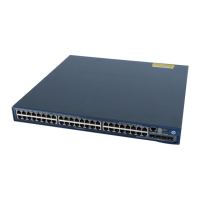107
Assign the current access port(s) to a
VLAN
Optional
By default, all access ports
belong to VLAN 1.
NOTE:
Before you assign an access port to a VLAN, create the VLAN.
In VLAN view, you can assign only Layer 2 Ethernet interfaces to the current VLAN.
After you configure a command on a Layer 2 aggregate interface, the system starts applying the configuration to
the aggregate interface and its aggregation member ports. If the system fails to do that on the aggregate
interface, it stops applying the configuration to the aggregation member ports. If it fails to do that on an
aggregation member port, it skips the port and moves to the next port.
Assigning a trunk port to a VLAN
A trunk port can carry multiple VLANs. You can assign it to a VLAN in interface view (including Ethernet
interface view, Layer 2 aggregate interface view) or port group view.
Follow these steps to assign a trunk port to one or multiple VLANs:
Enter interface
view (including
Ethernet
interface view,
Layer 2
aggregate
interface view)
or port group
view
Enter Ethernet
interface view
interface interface-type interface-
number
Required
Use either command.
In Ethernet interface view, the
subsequent configurations apply
to the current port.
In port group view, the
subsequent configurations apply
to all ports in the port group.
In Layer 2 aggregate interface
view, the subsequent
configurations apply to the Layer
2 aggregate interface and all its
member ports.
Enter Layer 2
aggregate
interface view
interface bridge-aggregation
interface-number
port-group manual port-group-
name
Configure the link type of the
port or ports as trunk
Assign the trunk port(s) to the
specified VLAN(s)
port trunk permit vlan { vlan-id-list
| all }
Required
By default, a trunk port carries only
VLAN 1.
Configure the PVID of the trunk
port(s)
port trunk pvid vlan vlan-id
Optional
VLAN 1 is the PVID by default.

